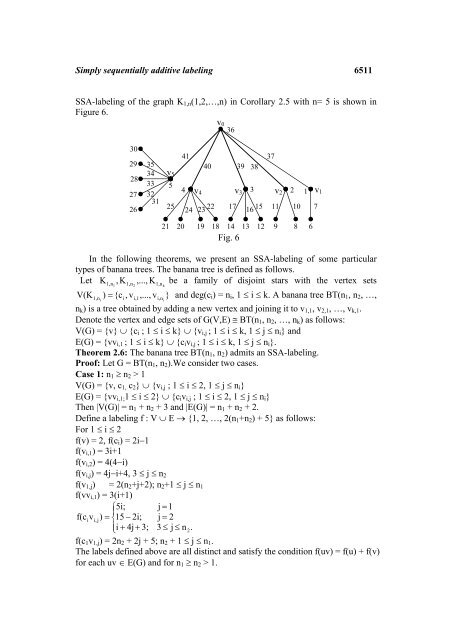Simply Sequentially Additive Labeling of Some Special Trees
Simply Sequentially Additive Labeling of Some Special Trees
Simply Sequentially Additive Labeling of Some Special Trees
You also want an ePaper? Increase the reach of your titles
YUMPU automatically turns print PDFs into web optimized ePapers that Google loves.
<strong>Simply</strong> sequentially additive labeling 6511<br />
SSA-labeling <strong>of</strong> the graph K1,n(1,2,…,n) in Corollary 2.5 with n= 5 is shown in<br />
Figure 6.<br />
30<br />
29<br />
28<br />
27<br />
26<br />
35<br />
34<br />
33<br />
32<br />
31<br />
In the following theorems, we present an SSA-labeling <strong>of</strong> some particular<br />
types <strong>of</strong> banana trees. The banana tree is defined as follows.<br />
K , K ,..., K be a family <strong>of</strong> disjoint stars with the vertex sets<br />
Let 1, n1<br />
1, n2<br />
1, nk<br />
V(K n ) i {ci<br />
, vi,1,...,<br />
vi,<br />
ni<br />
21<br />
v5<br />
5<br />
25<br />
4<br />
20<br />
41<br />
24<br />
v4<br />
19<br />
40<br />
22<br />
23<br />
18<br />
v0<br />
36<br />
1, = } and deg(ci) = ni, 1 ≤ i ≤ k. A banana tree BT(n1, n2, …,<br />
nk) is a tree obtained by adding a new vertex and joining it to v1,1, v2,1, …, vk,1.<br />
Denote the vertex and edge sets <strong>of</strong> G(V,E) ≅ BT(n1, n2, …, nk) as follows:<br />
V(G) = {v} ∪ {ci ; 1 ≤ i ≤ k} ∪ {vi,j ; 1 ≤ i ≤ k, 1 ≤ j ≤ ni} and<br />
E(G) = {vvi,1 ; 1 ≤ i ≤ k} ∪ {civi,j ; 1 ≤ i ≤ k, 1 ≤ j ≤ ni}.<br />
Theorem 2.6: The banana tree BT(n1, n2) admits an SSA-labeling.<br />
Pro<strong>of</strong>: Let G = BT(n1, n2).We consider two cases.<br />
Case 1: n1 ≥ n2 > 1<br />
V(G) = {v, c1, c2} ∪ {vi,j ; 1 ≤ i ≤ 2, 1 ≤ j ≤ ni}<br />
E(G) = {vvi,1;1 ≤ i ≤ 2} ∪ {civi,j ; 1 ≤ i ≤ 2, 1 ≤ j ≤ ni}<br />
Then |V(G)| = n1 + n2 + 3 and |E(G)| = n1 + n2 + 2.<br />
Define a labeling f : V ∪ E → {1, 2, …, 2(n1+n2) + 5} as follows:<br />
For 1 ≤ i ≤ 2<br />
f(v) = 2, f(ci) = 2i−1<br />
f(vi,1) = 3i+1<br />
f(vi,2) = 4(4−i)<br />
f(vi,j) = 4j−i+4, 3 ≤ j ≤ n2<br />
f(v1,j) = 2(n2+j+2); n2+1 ≤ j ≤ n1<br />
f(vvi,1) = 3(i+1)<br />
⎪<br />
⎧5i;<br />
j = 1<br />
f(ci<br />
vi,<br />
j)<br />
= ⎨15<br />
− 2i; j = 2<br />
⎪⎩ i + 4j + 3; 3 ≤ j ≤ n 2.<br />
f(c1v1,j) = 2n2 + 2j + 5; n2 + 1 ≤ j ≤ n1.<br />
The labels defined above are all distinct and satisfy the condition f(uv) = f(u) + f(v)<br />
for each uv ∈ E(G) and for n1 ≥ n2 > 1.<br />
17<br />
14<br />
39<br />
v3<br />
Fig. 6<br />
3<br />
15<br />
16<br />
13<br />
38<br />
12<br />
37<br />
v2<br />
11<br />
9<br />
2<br />
10<br />
8<br />
1<br />
6<br />
v1<br />
7
















